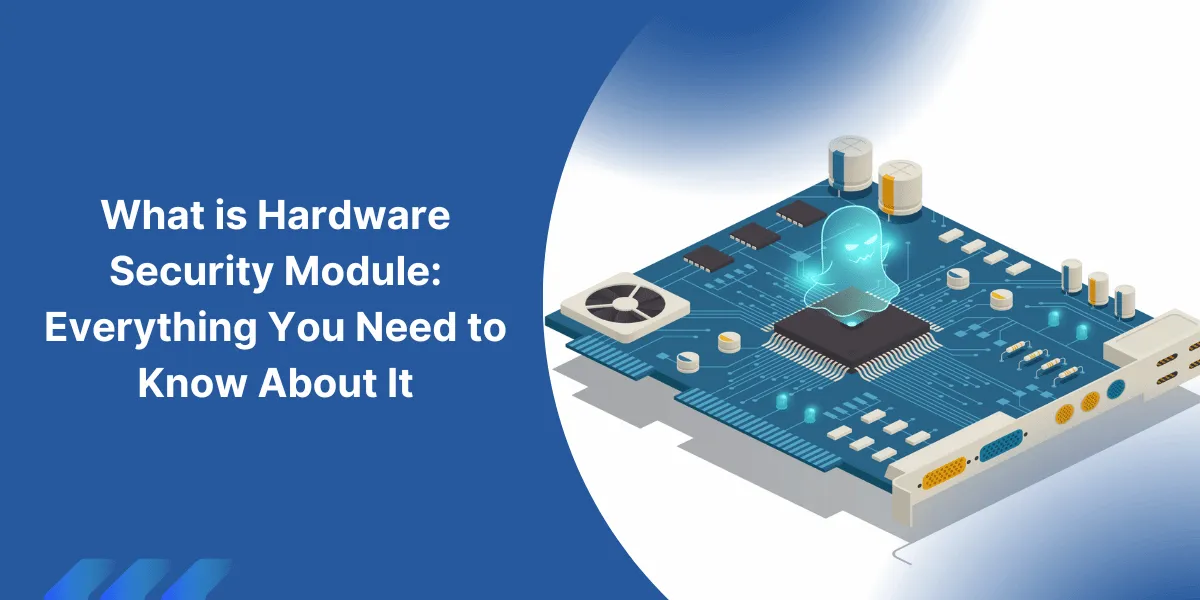Understanding Hardware Security Module (HSM)
A Hardware Security Module (HSM) is a physical computing device that provides extra security for sensitive data. HSMs are designed to safeguard and manage digital keys, accelerate cryptographic processes, and provide strong authentication methods.
How Hardware Security Module Works
An HSM is essentially a secure crypto processor that generates, protects, and manages cryptographic keys. It’s a dedicated microcontroller that’s hardened both logically and physically to resist tampering and bus probing. HSMs store encryption keys in protected partitions and provide cryptographic operations using the protected keys.
Some core capabilities of HSMs include:
- Key Generation: HSMs can quickly generate cryptographic keys with high entropy. This includes symmetric keys, asymmetric key pairs, and more.
- Key Protection: HSMs store keys in tamper-resistant hardware so they are protected even if the HSM is physically compromised. Keys are never exposed outside the cryptographic boundary of the HSM.
- Key Management: HSMs enable lifecycle management of cryptographic keys including capabilities like key rotation, archiving, and destruction. This reduces operational risks.
- Cryptographic Acceleration: HSMs use dedicated hardware to accelerate compute-intensive cryptographic algorithms like asymmetric encryption/decryption. This improves performance.
- Strong Authentication: HSMs provide multi-factor authentication methods to control access to keys. This includes PINs, passphrases, and physical tokens such as YubiKey Token.
To use an HSM, applications and servers connect to the HSM using industry standard APIs like PKCS#11, Java Cryptography Extensions, and Microsoft Cryptography API. The HSM intercepts all cryptographic operations and performs them within its secure hardware boundary. Keys are never exposed in plaintext form outside the HSM.
Types of Hardware Security Modules
PCI HSMs
PCI HSMs are card-style units that slide into PCI slots within servers. They offer better performance than USB HSMs since they integrate directly with the server’s internal bus. PCI HSMs are a common choice for document signing, SSL/TLS, and database encryption use cases.
Network HSMs
Network HSMs are dedicated appliances that connect to servers over internal IP networks. They provide centralized key storage accessible by multiple servers. Active-active high availability clusters prevent downtime. Network HSMs scale well and are widely used for PKI, code signing, and cloud applications.
USB HSMs
USB HSMs are portable units that connect to servers via USB ports. They provide a basic low-cost option suitable for small-scale use cases. USB HSMs are popular for email signing, blockchain wallets, and document encryption. But throughput is limited due to USB 2.0 speeds.
Cloud HSMs
Cloud HSMs provide HSM key storage, cryptographic operations, and access control through a cloud provider like AWS or Azure. They allow organizations to integrate HSM capabilities into cloud-based applications. But organizations cede physical control of the hardware to the cloud provider.
Why Use Hardware Security Modules?
There are several key reasons organizations deploy HSMs:
- Compliance: Many regulations like PCI DSS, HIPAA, and GDPR recommend or require the use of HSMs for strong key protection. HSMs help meet compliance mandates.
- Secure Key Storage: HSMs provide tamper-resistant storage for cryptographic keys. If a server is compromised, the keys within an HSM remain secure.
- Faster Cryptography: HSMs use dedicated hardware to accelerate compute-heavy cryptographic operations. This improves efficiency especially for public key encryption/decryption.
- Stronger Access Control: HSMs provide strict access control using multi-factor authentication. This reduces the risks of unauthorized key access.
- Scalability: HSM pools and high-availability clusters allow organizations to scale up HSM capabilities as their cryptographic workloads grow over time.
Pros and Cons of Hardware Security Modules
HSMs offer many benefits but also some downsides to consider:
Pros of Hardware Security Modules
- Strong tamper-resistant protection for keys.
- Accelerates compute-heavy cryptographic processing like RSA.
- Meets compliance mandates for encryption, signing, etc.
- Simplifies integration by supporting standard APIs like PKCS#11.
- Scales up through high availability clustering.
- Manages entire lifecycle of cryptographic keys.
- Supported by all major operating systems and applications.
Cons of Hardware Security Modules
- Strong tamper-resistant protection for keys.
- Accelerates compute-heavy cryptographic processing like RSA.
- Meets compliance mandates for encryption, signing, etc.
- Simplifies integration by supporting standard APIs like PKCS#11.
- Scales up through high availability clustering.
- Manages entire lifecycle of cryptographic keys.
- Supported by all major operating systems and applications.
HSM Architecture
HSMs utilize a specific architecture optimized for secure key operations:
Hardened Security Boundary
The entire HSM operates within a protected hardware boundary that resists both physical and electronic attacks. All sensitive cryptographic operations occur entirely within this security perimeter.
Private Key Storage
Encryption keys are stored in tamper-resistant memory or crypto modules only accessible by the HSM’s internal security logic. Keys never leave the HSM’s boundary unencrypted.
Access Control Module
The HSM grants access to stored keys only after successful authentication based on embedded PINs, passphrases, smart cards, and/or biometrics. Role-based authorization limits users’ access.
Cryptographic Accelerator
Specialized hardware executes cryptographic algorithms like RSA or ECC. Offloading this computation provides high-performance encryption/decryption.
Interface Layer
Standardized interfaces like IP networking, PKCS#11, or the Cloud HSM Client allow external applications to interact with the HSM for key storage, cryptographic operations, etc. But no direct access to keys is permitted.
Physical Security
External protective measures like tamper-evident seals, tamper-response envelopes, and Faraday cages shield the HSM from physical penetration or side-channel attacks.
This architecture allows organizations to securely leverage the HSM’s cryptographic capabilities without exposing sensitive keys.
HSM Use Cases
HSMs have a wide range of applications across many different industries:
Public Key Infrastructure (PKI)
HSMs are almost universally used to protect the certificate authority (CA) keys that form the root of trust for PKI. CA private keys issue and sign all certificates within the PKI. If these keys are compromised, it can fatally undermine the entire PKI. HSMs provide the gold standard for securing CA private keys.
Document Signing
Many industries rely on digital signatures for documents like contracts, invoices, transcripts, and prescriptions. HSMs protect the private keys used for document signing, preventing unauthorized signing or forgery.
User Authentication
Organizations can store user credentials inside HSMs to provide strong multi-factor authentication. For example, biometric data, passwords, or FIDO keys can be stored inside HSMs instead of vulnerable databases.
Secure Sockets Layer (SSL)
HSMs are ubiquitously used to protect the private keys associated with SSL/TLS certificates on web servers. This protects ecommerce transactions, web logins, and other sensitive web traffic against man-in-the-middle attacks.
Database Encryption
Database encryption keys can be securely generated, stored, and managed inside HSMs. This protects sensitive data at rest within databases.
Blockchain Applications
Cryptocurrencies, NFTs, and decentralized networks rely on public-key cryptography. HSMs safeguard the private keys for blockchain wallets and sign transactions.
Cloud Security
Cloud providers often leverage HSMs to protect customer data and keys within their cloud servers. Customers can also use cloud based HSMs.
And Many More…
HSMs secure keys for ATMs, POS terminals, code signing, voting systems, lottery terminals, and countless other applications. They provide a foundation for cryptographic security across industries.
How HSMs Provide Security
HSMs secure keys through a combination of tamper-resistant hardware and strict access controls:
Tamper-Resistant Hardware
HSMs use hardened hardware defenses to prevent physical attacks:
- Tamper-evident seals and casings allow any physical compromise attempts to be detected.
- Sensors detect environmental anomalies like temperature changes, voltage fluctuations, and radiation that could aid attacks.
- Penetration membranes destroy secrets if the HSM is opened.
- Faraday cages block side-channel electromagnetic attacks.
- Active anti-tampering mechanisms like porous coatings destroy the chip if removal is attempted.
Together, these mechanisms make it extremely difficult for an attacker to extract keys from a compromised HSM.
Access Controls
HSMs provide multilayered access controls to restrict use of keys:
- Something you know: PINs or passphrases must be entered to use the HSM.
- Something you have: Physical tokens or smart cards are required.
- Something you are: Biometrics like fingerprints authenticate administrators.
- Authorization roles: Keys and operations are restricted using privilege levels.
- Multifactor authentication: Combining PINs, biometrics, and tokens provides layered security.
- Activity logging: Detailed audit logs record all access attempts and actions.
These controls prevent unauthorized users from breaching the HSM, even if they have physical access to it. The keys remain cryptographically secured.
Key Management
HSMs provide tools to properly manage keys throughout their lifecycle:
- Keys are always generated securely inside the HSM.
- Keys have limited validity periods and eventually expire.
- Compromised or expired keys can be destroyed irreversibly.
- Key backups are strictly access controlled.
- Keys can be archived and stored offline.
Together, these capabilities reduce the risk of key compromises while maintaining business continuity.
Trusted Platform Module
Some HSM models include an additional trusted platform module (TPM), which provides hardware-based security features like:
- Binding keys to specific HSM hardware to detect tampering or cloning.
- Hardware-based random number generation for superior entropy.
- Remote attestation to validate the HSM’s hardware/software state.
- Secure non-volatile storage for measurements like PCRs.
TPMs strengthen the hardware root of trust and enable advanced supply chain assurances for HSMs.
FIPS 140-2 Validation
Most enterprise HSMs are validated to FIPS 140-2 Level 2 or Level 3. FIPS 140-2 is a critical security standard published by NIST that establishes requirements for cryptographic modules like HSMs. By obtaining FIPS 140-2 validation, HSM vendors demonstrate independent third-party testing and assurance of their security capabilities.
HSM Security Considerations
While HSMs provide very strong security, organizations must take steps to maximize their protections:
- Purchase units validated to FIPS 140-2 Level 3 and Common Criteria EAL4+ for assurance.
- Require tamper-evident seals and casings to detect physical compromise.
- Limit and monitor physical access to HSMs to authorized personnel only.
- Enforce principles of least privilege and separation of duties for access control.
- Require multifactor authentication including PINs, biometrics, and smart cards.
- Rotate, backup, and archive keys according to best practices.
- Utilize clustered HSMs in active/active mode for redundancy.
- Monitor HSM system health, performance, and access diligently.
- Validate proper HSM functionality annually and after any significant change.
- Ensure technical staff are trained to configure and operate HSMs securely.
Final Thoughts
Hardware security modules provide hardened protection for sensitive cryptographic keys. By leveraging tamper-resistant hardware and strict access controls, HSMs offer security superior to software key storage. They help mitigate the risks of key compromise from both remote attacks and insider threats.
For highly security-conscious organizations, HSMs are considered a best practice for safeguarding private keys, accelerating encryption, enabling multifactor authentication, and satisfying compliance requirements. HSMs have become ubiquitous for public key infrastructure, databases, applications, network devices, and more. Despite their costs, HSMs deliver the gold standard for encryption key security in the modern era.
Frequently Asked Questions About HSMs
What are the most important factors to consider when selecting an HSM?
The most important selection criteria are security level, performance, form factor, high availability capabilities, and remote management functionality. Organizations should balance their security needs, performance requirements, budget constraints, and ease-of-use preferences when selecting an HSM.
What is a Hardware Security Module (HSM)?
An HSM is a physical computing device that safeguards and manages digital keys, accelerates cryptographic processes, and provides strong authentication for SSL/TLS connections.
Why are HSMs used?
HSMs provide robust protection for private keys, enable secure cryptographic processing, and offload the computational burden from servers for faster SSL/TLS transactions.
What are some key features of an HSM?
Encryption/decryption, random number generation, secure storage, tamper-resistance, scalability, redundancy, and compliance with standards like FIPS 140-2 Level 3.
Where are HSMs commonly deployed?
Within certificate authorities, public key infrastructures, banks, large enterprises, and government agencies that handle sensitive data.
What are the benefits of using an HSM?
Stronger cryptographic security, reduced SSL/TLS latency, protection against threats, prevention of key compromise, and compliance with regulations.
What are some leading HSM manufacturers?
Thales, Entrust, Utimaco, Futurex, Marvell, and AWS CloudHSM. Popular models include nShield, Luna, CryptoServer, and more.

Priya Mervana
 Verified Web Security Experts
Verified Web Security Experts
Priya Mervana is working at SSLInsights.com as a web security expert with over 10 years of experience writing about encryption, SSL certificates, and online privacy. She aims to make complex security topics easily understandable for everyday internet users.



